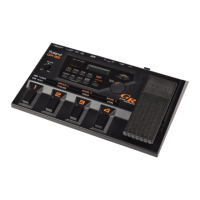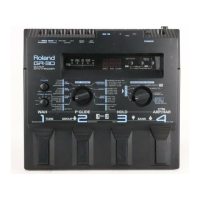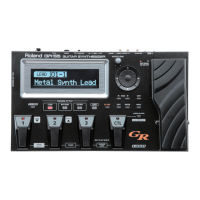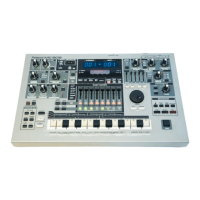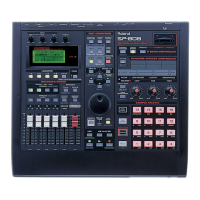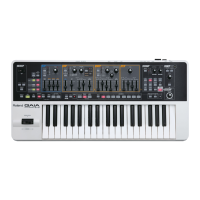Sequencing
Once you’ve got everything set up, you can record a sequencer track, punch
in, or record additional tracks from the GR-20 the same way you’d record
from a MIDI keyboard—again, your sequencer’s documentation is the best
source for specific instructions n recording.
What the GR-0 Sends Out
MIDI has a set of “Control Change” messages that represent common
behaviors in a MIDI instrument.
Here’s a bit more detail on what the GR-20 does during sequencing:
When you start to play each note on your guitar—the
GR-20 sends out a MIDI note-on message for that note.
When you stop playing a note—the GR-20 sends out a
note-off message.
When you bend strings—the GR-20 sends out pitch bend
messages that mimic the behavior of your string bends.
When you press the GR-20 GLIDE pedal—the GR-20 sends
out pitch bend messages that mimic the way your notes’
pitches change when GLIDE is pressed.
When you press the GR-20 HOLD pedal—the GR-20 sends
out MIDI messages that describe what the pedal does to
your notes. If the HOLD pedal is set to:
H1, H2, or H3—the GR-20 stops sending out note-off
messages until you release the pedal.
H4—the GR-20 sends out a sustain pedal-on (Control Change #64)
value for as long as you press the HOLD pedal down.
Sustain pedal messages sent from the GR-20’s HOLD pedal work best
when you’re sequencing in Mono mode.
•
•
•
•
•
•
•
When you move the GR-20 Expression pedal—the GR-20 sends
out MIDI Control Change messages, depending on the pedal’s
configuration. If it’s set to:
Vo—the GR-20 sends out volume change (Control
Change #7) values as you rock the pedal.
Fl or EF—the GR-20 sends out foot pedal (Control Change
#4) values when you rock the pedal.
When the patch’s RELEASE knob is set to E FLW—the
GR-20 sends out General Purpose Controller (Control
Change #18) values. If your sequencer’s playing a
GR-20 sound, these values set the GR-20’s Release
parameter to E FLW.
Tips for Successful Sequencing
Here are some tips for sequencing with the GR-20:
Play as cleanly as possible—as always with the GR-20. If you do wind up
with extra or unwanted notes in the recorded sequencer track, you can
always delete them, thanks to the ease with which MIDI data can be
edited in a sequencer.
If you’re having trouble playing in time with the sequencer—slow the
sequencer’s tempo down. You can speed it back up on playback. (One
of the advantages of MIDI is that you can change a performance’s
tempo even after recording.)
If you’re having trouble playing a complex part—break the part up into
simpler components you can record separately on different tracks.
Your sequencer will allow you to merge them into a single track after
recording.
If you’re recording notes you didn’t actually play—
set up your sequencer to ignore the unintended
notes. In MIDI, the force with which you play a
note is measured as a “velocity” value. Higher
velocity values, up to 127, mean louder notes,
while lower velocity values mean quieter notes.
Most often, unwanted notes are played softly. You
may be able to set up your sequencer so it ignores
notes with a velocity value of 25 or less.
•
•
•
•
•
•
•
•
Playing softly
=low velocity
Playing hard
=high velocity

